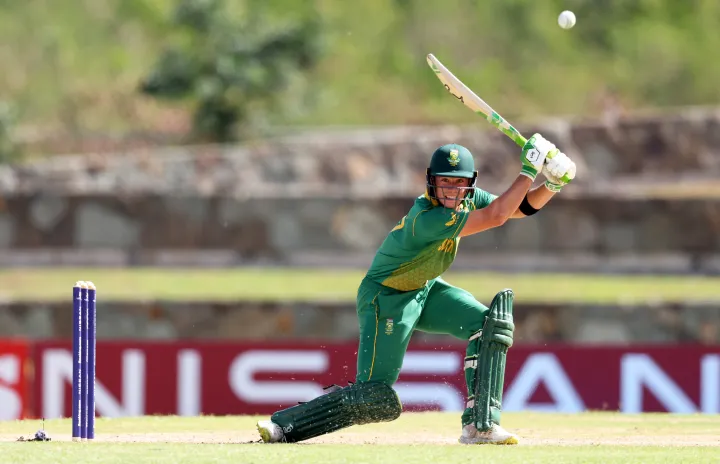
Bishan Singh Bedi has given cricket so much, and still his gifts keep coming. On Saturday the stand that bears his name and curves along the western boundary at the ground formerly known as the Kotla bequeathed a generous pool of shade that spread and deepened as the sun sank behind it.
The spectators gathered there would have been relieved to escape the sharp end of the 38-degree heat. But they still had to breathe air rated, forebodingly, as “very unhealthy”. It stained the sky the colour of a bedraggled dish towel, which had holes ripped into it by Delhi’s famous swooping and swirling black kites.
Not that Sri Lanka had time or opportunity for bird-watching, even though they spent much of the afternoon looking upward. They did so in search of the ball that South Africa’s batters had sent booming boundaryward. The Lankans couldn’t hide from the heat, and their increasingly heaving gasps as they chased leather meant they took in more of the dirty air than anyone else.
Except, perhaps, for Quinton de Kock, Rassie van der Dussen and Aiden Markram, who spent an accumulated 405 minutes – verging on seven hours – batting in the soupy stickiness. They scored 100, 108 and 106 to propel South Africa to 428/5, the highest total in all 440 games played in men’s World Cup history.
How long did Markram think that would be the benchmark? “The way batters are playing nowadays you wouldn’t be surprised if that record is broken in this competition,” he said, a startling admission for someone whose ton had come off 49 balls.
That made it the fastest of all the 201 centuries in the tournament’s annals, while the 204 De Kock and Van der Dussen shared off 174 is South Africa’s biggest stand for any wicket in their 81 ODIs against the Lankans.
How much of the way the South Africans batted was plotted and how much is what happens when a team’s innings grows wings bigger and stronger than a black kite’s?
“You do a lot of planning before the game,” Markram said. “It’s natural for teams to speculate about conditions, especially for South Africans coming over to India. You’re not always 100% sure how it’s going to play.
“Then you get out there and the wicket starts playing really well. It’s initially a big sigh of relief, and secondly your instinct takes over and it becomes a see-ball, hit-ball mentality. Marrying the two of them is crucial.”
Markram, one of the more demure players in the game, let loose a mighty yawp when he reached his century. De Kock and Van der Dussen, too, didn’t try to stave off animated celebrations. They gave rise to images of three bottles of freshly uncorked champagne.
“It’s quite strange; you almost get this thing that takes over your body at certain moments,” Markram said. “There’s a lot of passion in this team to give our absolute all at this World Cup and see how far it can get us.
“We’ve been known to start slowly so we put a lot of emphasis on today’s game, to start well and play the same cricket we’ve been playing to manage to sneak into this competition. All of those emotions mixed up and building up comes out.”
In fact South Africa have won six of their eight opening matches at a World Cup. But the two they lost became attached to memories they would prefer not to have: at home in 2003, when they crashed out of the tournament in the pool stage, and in England in 2019, when they slumped to their worst performance in the event by losing five of their completed eight matches. So Saturday’s success meant more, to the players, than just one win.
Similarly, with South Africa building a wall of runs and records it wasn’t a day for picking out particular strokes. But De Kock’s sweetly timed off-side dab in the 31st to a wide delivery from Matheesha Pathirana, sending it scooting away for four, stood out. As did David Miller hitting Kasun Rajitha into the stratosphere for a straight six to end the 49th, which had Tabraiz Shamsi in the dugout covering his mouth with his hand in empathy.
And to think so brutal an onslaught had begun placidly, with De Kock and Van der Dussen needing until midway through the 18th to bring up the hundred. The Lankans had put some back into their new-ball effort and occasional deliveries skidded on, which was how Temba Bavuma was trapped in front by Dilshan Madushanka in the third.
But the effects of the sun, the air, the flattening pitch and the small, fast outfield mounted, and the South Africans escaped the leash in the 23rd. With De Kock hitting Dhananjaya de Silva for four through the covers and six over long-on, the over went for a dozen runs and took South Africa’s runrate for the innings into double figures. They never looked back. Even Bedi might have struggled to reel them in. That Sri Lanka fielded judiciously told its own story. How many more runs would they have haemorrhaged had they been sloppy?
The crowd of 15,496 would have swelled the stands and grass banks in most of South Africa’s major grounds, but in Delhi they amounted to little more than a third of capacity. They probably thought they had seen their money’s worth during the interval, and more so when Marco Jansen’s first delivery nailed a flummoxed Pathum Nissanka’s middle stump. Happily, the fans would have been mistaken.
Kusal Mendis tore into his task gusto that suggested he thought the target – more than Sri Lanka had scored or even chased to win an ODI – was attainable. He scored 51 of their first 54 runs, and took his team to 94/2 after 10. At the same stage South Africa had been 48/1.
But Hurricane Mendis always looked like blowing itself out. It was a question of when, which was answered in the 13th – he edged a widish, sharply bouncing delivery from Kagiso Rabada to Klaasen, who kept wicket in the absence of the cramping De Kock.
That was the first of three wickets that fell for 41 in 45 balls. With them went any chance the Lankans might have had of answering their massive ask in the affirmative. Charith Asalanka and Dasun Shanaka scored half-centuries – the latter’s was his first in 20 completed white-ball innings – and they shared 82 off 72. But it was all for show, not dough.
Maybe the South Africans knew that, too. It would explain their messy display in the field, and the three dropped catches and another chance that didn’t go to hand. The plan seemed to be to bowl straight, but that left minimal margin for error given the willing pitch and the confines of the ground.
When you’ve piled up 428, slipping discipline is unlikely to come back to bite you where it hurts. But that won’t wash against more competitive opponents – like Australia, who South Africa face in Lucknow on Tuesday. Before then they should rope in Bishan Singh Bedi to conduct a masterclass.







